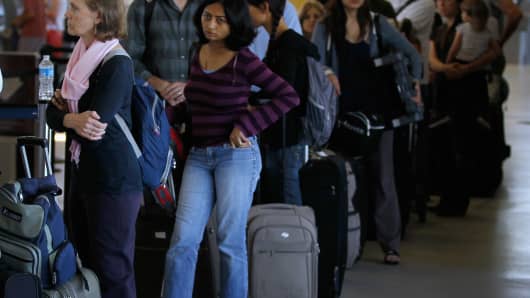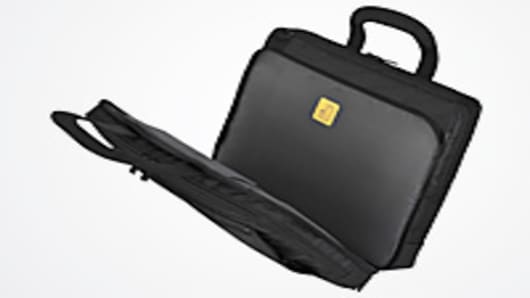For harried business travelers, time is money. Many products and services are billed as ways to get you to the airport gate sooner. But does it pay to spend a few extra dollars to save time in the airport security line?
For experienced road warriors, it’s about knowing what the Transportation Safety Administration, TSA, expects — and then packing right. Indeed, road warriors' dealings with the TSA have resulted in a whole new industry: TSA-approved products.
“I’ve traveled so much, it is second nature,” Rob Fleischer, a New York-based public relations executive, says. “You have to travel light these days.”
He says having the right bag ensures that he’s not wasting time with the TSA screeners.
So-called TSA friendly bags, which offer the promise of streamlining the security process, have become big business for luggage makers.
For example, Briggs & Riley is expanding its line to accommodate the growth of personal computing devices, including tablets and eReaders. At rival Targus, the design of TSA-friendly business cases has been aggressively expanded into more informal and casual lines.
“We started in 2006 to introduce a laptop case that didn’t require that you take the laptop out,” says Richard, Krulik, CEO of Briggs & Riley. “This got the TSA thinking about what could speed the scanning process.”
The result is what has become an industry standard of sorts, the so-called clam shell or butterfly design — where a laptop can remain within a sleeve but with nothing above or below it — the main stipulation from TSA.
“At this point, it is a norm for travel bags that can separate the laptop from the other items,” says Al Giazzon, vice president of marketing and communications at Targus.
However, all bags billed as being TSA-friendly may not be.
“While those larger luggage makers know what TSA expects, there are plenty of smaller brands that make claims that aren’t true,” says Billy Pidgeon, a business and travel analyst at M2 Research.
As an agency, the TSA doesn’t actually “approve” any laptop bags.
“We don’t say ‘TSA approved,’ but there are airport-friendly screening bags,” says Greg Soule, TSA spokesman. “All fliers should check our website to know what to look for.”
"You have to travel light these days."
One TSA guideline that is far more specific relates to liquids, including toiletries — and here an entirely new niche market has sprung up, with numerous online retailers offing TSA-mandated sizes of 3 ounces or less, but with notably inflated prices.
“These products do cost more, but if you need it, what choice do you have?” asks Ken Walker, business travel columnist for AllBusiness. He says many employers are taking another approach to ease the wait. “Some companies will reimburse you for shampoo or contact lens solution, so instead of even bringing it, you just buy it when you get to your destination.”
Then why would anyone pay more if they can just pick it up once they reach their hotel?
Fear and convenience, says Pidgeon. “While many don’t want the wrath of TSA at the screener for having too many liquids, for others it is about getting through the line at the airport without hassle, and not having to run to the drug store, or worrying about whether the size sold in the hotel lobby is one ounce too big.”
There are other ways to get to the scanners faster. The most obvious is to earn a higher frequent-flier status on a particular airline, which offers you a shorter wait to the scanners.
Other programs have been introduced to allow for pre-approved passengers, who must go through increased background checks prior to travel, to undergo expedited screening.
These Customs and Border Protection Trusted Traveler programs, which now include Global Entry, SENTRI and NEXUS, launched in 2006. Lack of one standardized system, however, resulted in approved travelers ending up back in the long line.
“There are multiple companies that have tried to provide that ‘no TSA checkpoint,’ ” Walker said. “The problem is that the government didn’t really sign on, so these services were offered only at select airports. If you’re like me and you fly all over, you have to pay up to $500 for each service.”
TSA is now starting fresh, using prescreening efforts to make intelligence-based risk assessments on passengers who voluntarily participate in the TSA PreCheck program and are flying domestically on select American Airlines and Delta Air Linesflights from Atlanta, Detroit, Dallas/Fort Worth and Miami International airports. The program is gaining momentum, with the TSA reporting more than 200,000 passengers using the program since it began in October. It recently expanded to Las Vegas, and will soon start on selected flights from New York's Kennedy International, Los Angeles International, Minneapolis-St. Paul and Salt Lake.
Participating airlines are “inviting” eligible fliers in advance, says TSA’s Soule. “Passengers go through a screening prior to arriving at the airport, so while they will go through a dedicated line, they would also routinely receive expedited screening.”
This program uses pre-screening capabilities to make intelligence-based risk assessments on passengers who voluntarily enter the PreCheck program. Those who haven’t been invited by their airline can still take part through Trusted Traveler, but does this mean it could become a repeat of what we’ve seen before?
“The biggest issue is that there is really no consistency to these programs,” says Wayne Plucker, industry manager for aerospace and defense at Frost & Sullivan. “So much varies on the airports, many of which were designed even before security checkpoints were required.”



